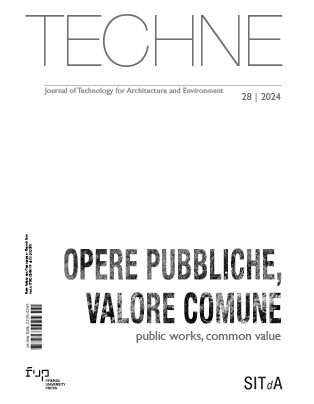Published 2024-10-29
Keywords
- Urban regeneration,
- Disposal,
- Public space,
- Technology park,
- Innovation
How to Cite
Copyright (c) 2024 Loredana Ficarelli, Mariangela Turchiarulo, Valentina Vacca

This work is licensed under a Creative Commons Attribution 4.0 International License.
Abstract
Universities not only play the role of social elevator but also stand as a development engine for the Territories hosting them, through synergies between institutions and businesses. The Innovation Park project at the former Magrone Barracks is an innovative example of management and rehabilitation of abandoned state-owned property for creating a fragment of Bari’s urban landscape by expressing common values in which the University, the City and extended territorial areas can recognise themselves. There is a need for a paradigm shift in the interpretation of the design of these facilities, which can become genuine integrated “urban factories”, Community Hubs capable of offering new spaces for the urban fabric, attracting talent and generating businesses.
Downloads
References
- Amoroso, S. and Hervás Soriano, F. (2019), “An International Perspective on Science and Technology Parks”, in Amoroso, S., Link, A.N. and Wright, M. (Eds.), Science and Technology Parks and Regional Economic Development: An International Perspective, Springer International Publishing, Cham, pp. 1-8. Available at: https://doi.org/10.1007/978-3-030-30963-3_1. DOI: https://doi.org/10.1007/978-3-030-30963-3_1
- Bellini, O.E. (2019), Student housing 2. Il progetto della residenza universitaria nella città contemporanea, Maggioli Editore, Santarcangelo di Romagna.
- Bettencourt, L., Lobo, J., Helbing, D., Kühnert, C. and West, G. (2007), “Growth, Innovation, Scaling, and the Pace of Life in Cities”, Proceedings of the National Academy of Sciences of the United States of America, Vol. 104, pp. 7301-6. Available at: https://doi.org/10.1073/pnas.0610172104. DOI: https://doi.org/10.1073/pnas.0610172104
- Braun, H. and Gromling, D. (2005), Research and Technology Buildings: A Design Manual, Birkhauser-Publishers for Architecture, Basel. Available at: https://doi.org/10.1007/3-7643-7672-4_13. DOI: https://doi.org/10.1007/3-7643-7672-4_13
- Catalano, G. (Ed.) (2014), Gestire le residenze universitarie. Aspetti metodologici ed esperienze applicative, Il Mulino, Bologna.
- De Carlo, G. (Ed.) (1968), Pianificazione e disegno delle Università, Edizioni Universitarie Italiane, Roma.
- Ficarelli, L. (Ed.) (2020), Ri-POLIBA: 2013-2019, progetti per gli spazi dell’università, Libria, Melfi.
- Lund, E. (2019), “The Strategic Choices That Science and Technology Parks Must Make”, in Amoroso, S., Link, A.N. and Wright, M. (Eds.), Science and Technology Parks and Regional Economic Development: An International Perspective, Springer International Publishing, Cham, pp. 9–24. Available at: https://doi.org/10.1007/978-3-030-30963-3_1. DOI: https://doi.org/10.1007/978-3-030-30963-3_2
- Mancuso, S. (2023), Fitopolis, la città vivente, Gius. Laterza & Figli Spa, Bari-Roma.
- Rossi, A. (2016), L’architettura della città, 5th ed., Quodlibet, Macerata.
- Setti, G. (2017), Oltre la dismissione: strategie di recupero per tessuti e manufatti industriali, LetteraVentidue, Siracusa.
- Toffolon, M. (2022), “Così l’università recupera gli edifici storici dismessi”, Il giornale dell’Architettura (Online). Available at: https://ilgiornaledellarchitettura.com/2022/03/30/cosi-luniversita-recupera-gli-edifici-storici-dismessi/ (Accessed on 20/02/2024).






